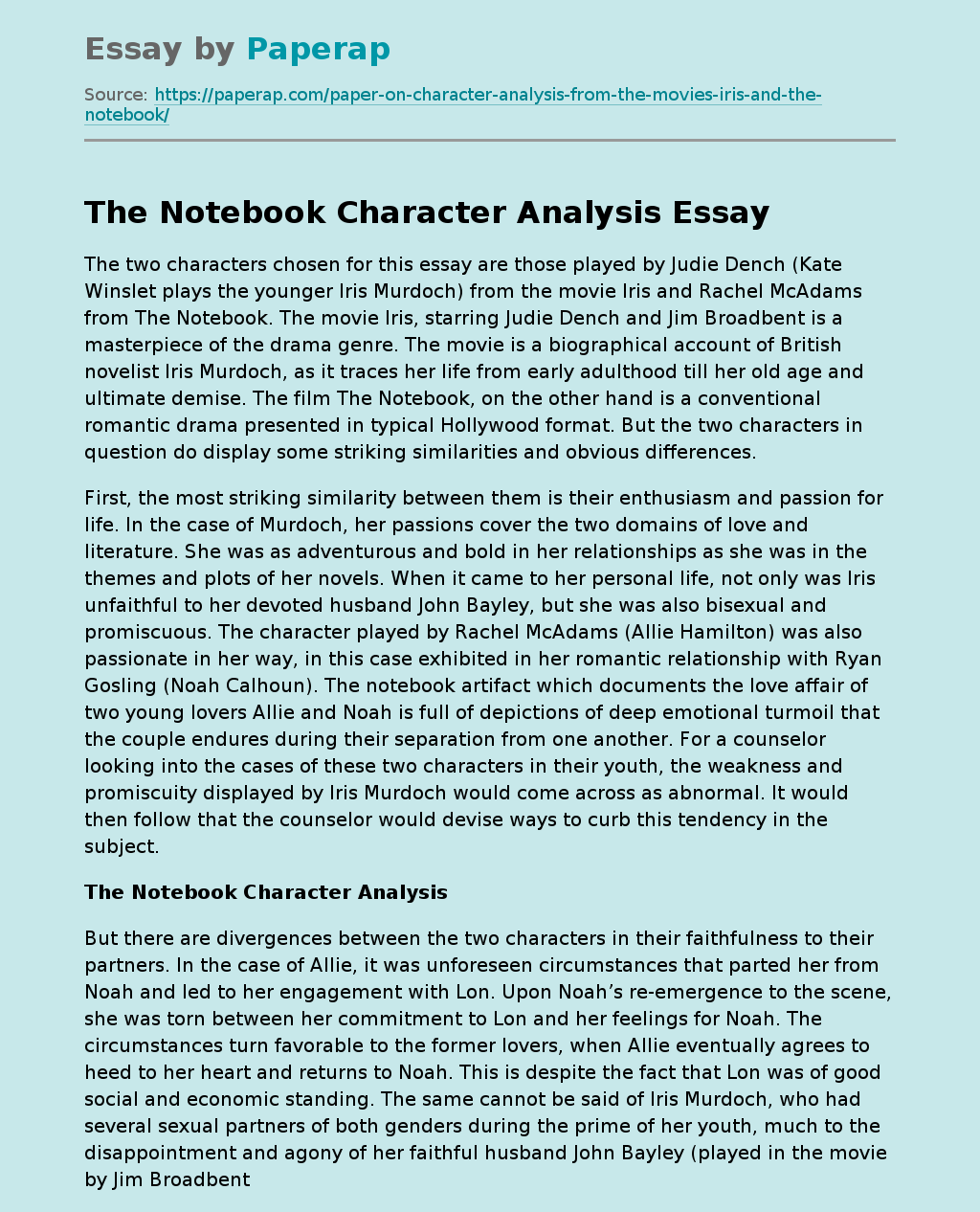The Notebook Character Analysis
The two characters chosen for this essay are those played by Judie Dench (Kate Winslet plays the younger Iris Murdoch) from the movie Iris and Rachel McAdams from The Notebook. The movie Iris, starring Judie Dench and Jim Broadbent is a masterpiece of the drama genre. The movie is a biographical account of British novelist Iris Murdoch, as it traces her life from early adulthood till her old age and ultimate demise. The film The Notebook, on the other hand is a conventional romantic drama presented in typical Hollywood format.
But the two characters in question do display some striking similarities and obvious differences.
First, the most striking similarity between them is their enthusiasm and passion for life. In the case of Murdoch, her passions cover the two domains of love and literature. She was as adventurous and bold in her relationships as she was in the themes and plots of her novels. When it came to her personal life, not only was Iris unfaithful to her devoted husband John Bayley, but she was also bisexual and promiscuous.
The character played by Rachel McAdams (Allie Hamilton) was also passionate in her way, in this case exhibited in her romantic relationship with Ryan Gosling (Noah Calhoun). The notebook artifact which documents the love affair of two young lovers Allie and Noah is full of depictions of deep emotional turmoil that the couple endures during their separation from one another. For a counselor looking into the cases of these two characters in their youth, the weakness and promiscuity displayed by Iris Murdoch would come across as abnormal.
It would then follow that the counselor would devise ways to curb this tendency in the subject.
The Notebook Character Analysis
But there are divergences between the two characters in their faithfulness to their partners. In the case of Allie, it was unforeseen circumstances that parted her from Noah and led to her engagement with Lon. Upon Noah’s re-emergence to the scene, she was torn between her commitment to Lon and her feelings for Noah. The circumstances turn favorable to the former lovers, when Allie eventually agrees to heed to her heart and returns to Noah. This is despite the fact that Lon was of good social and economic standing. The same cannot be said of Iris Murdoch, who had several sexual partners of both genders during the prime of her youth, much to the disappointment and agony of her faithful husband John Bayley (played in the movie by Jim Broadbent). Hence their love lives were crucially different in this respect.
Another common thread linking the two characters is their struggle with Alzheimer’s disease and associated dementia during the latter part of their lives. The deteriorating mental condition of Iris Murdoch is more poignant and thematically significant, for the mental faculty is the foremost asset of a writer. Hence, the challenges she faced were two-fold – their social implication and their professional implication. For a counselor, the case of Iris Murdoch would be much more difficult to treat, as the manifestation of Alzheimer’s disease in her was gradual, prolonged and in the end proved very acute. Having lived an accomplished life as a philosopher and novelist, her intellect was her greatest asset. And the severe decline in this faculty must have deeply affected Murdoch’s psyche as well. The writer’s lifestyle demanded that she go on lecture tours and keep other engagements with the academia and civil society, which would prove very embarrassing for her and more so for her husband.
In the case of Allie, though, after marrying Noah, she settles into a fairly domestic role. After raising a family with him and having brought up their children, she could consider herself to have fulfilled her duties. And what she would have hoped for at that juncture was that her last days went in a contented and peaceful manner. But that hope was not fulfilled, as her dementia steadily worsened leaving her memory and cognitive ability in a bad shape. As a counselor, Allie’s case is a little less hard than that of Iris to deal with, for the focus would be to rehabilitate her to get by in the domestic setting. Even if her Alzheimer’s would worsen, she could be accommodated into a palliative care setting under the care of nurses specialized in this area.
Hence, in conclusion, the characters of Iris Murdoch and Allie both leave indelible marks on the psyche of the viewers. They share many similarities, the most striking and poignant of which is their terminal struggle with Alzheimer’s disease and the attendant dementia. Treating them in coping with their illness is an arduous task for the counselor, for both their mental and physical condition would get progressively worse. Yet, among the two, Allie was a little easier to rehabilitate, for she had a fairly conventional lifestyle and her temperament too suited a palliative setting. Iris Murdoch on the other hand would have suffered immensely under captive palliative setting for she was used to living a full and vibrant professional and personal life.
References:
Bayley, John (1999) Iris and Her Friends: A Memoir of Memory and Desire. W. W. Norton & Company ISBN 0-393-32079-0
“The Notebook Movie Reviews, Pictures”. Rotten Tomatoes.Flixter. Retrieved 2010-11-02.
Conradi, Peter J. (2001). Iris Murdoch: A Life. W. W. Norton & Companys. p. 12.
The Notebook Character Analysis. (2019, Dec 05). Retrieved from https://paperap.com/paper-on-character-analysis-from-the-movies-iris-and-the-notebook/

